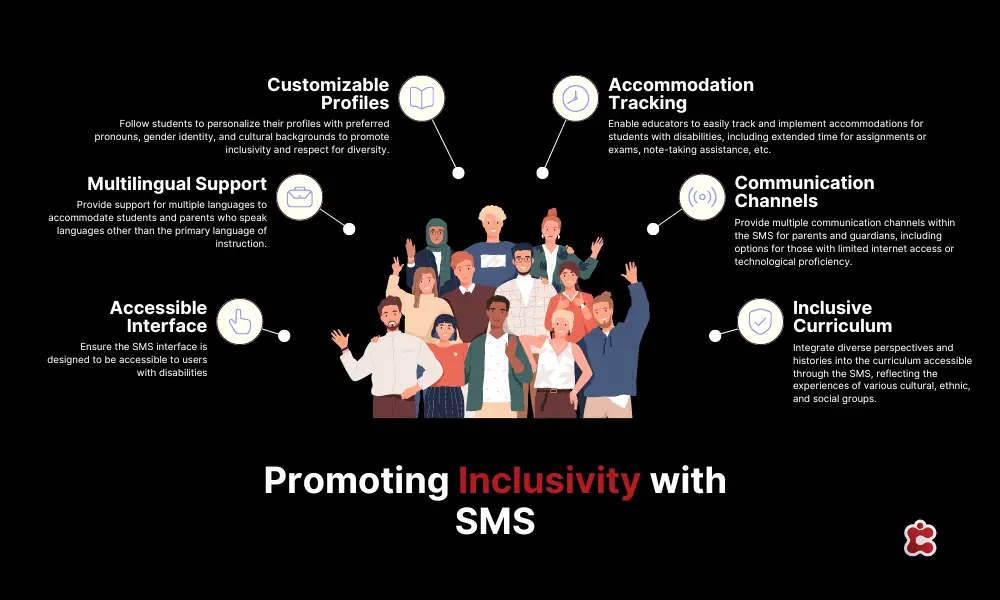Modern classrooms present modern opportunities. And student diversity is one of them. This diversity comes in various forms—cultural backgrounds, learning styles, abilities, and even socioeconomic statuses. As teachers, we cherish this diversity because it enriches everyone’s learning experience. However, it also presents unique challenges. How do we ensure that every student feels included and supported? How can we tailor our teaching methods to meet the needs of such a varied group of learners?
The answer lies in leveraging technology, specifically School Management Systems (SMS). These systems are not just administrative tools; they can be powerful allies in creating an inclusive classroom. Imagine having a centralized platform that helps you track student progress, identify those who need extra help, and communicate seamlessly with parents and guardians.
We will explore how you can harness the power of SMS effectively to create an inclusive classroom. Let’s dive in.

Key Features School Management Systems
There are several key features to look into when considering a School Management System to boost classroom inclusivity. You’d want to acquire a system that makes a significant difference in your workflow.
Here are some aspects to look for:
- Student Information Management: A well-rounded SMS should allow the educator to analyze comprehensive student profiles. This includes academic records, attendance, behavior logs, as well as personalized learning plans.
- Attendance and Behavior Tracking: Accurate attendance and behavior tracking is key to identifying patterns and proactively solving problems in student behavior. Software with a user-friendly interface for recording attendance is ideal. Automated alerts are also useful in notifying you and the parents about absences or behavioral concerns.
- Communication Tools: Building connections with parents, students, and co-workers is important for creating an inclusive environment. An SMS with integrated messaging systems, email notifications, and parent portals can streamline this process. These tools help keep everyone informed and engaged, making it easier to coordinate efforts and support students collaboratively.
- Gradebook and Assessment Management: Managing grades and assessments efficiently is crucial to an institution’s holistic functioning. A good SMS should provide an intuitive grade book feature that allows the educator to input, calculate, and analyze grades with ease. Furthermore, it should also provide valuable insights into student performance trends, assisting in pinpointing areas where students might require extra help.
- Personalized Learning: The system should support personalized learning paths to cater to diverse learning styles and needs. Features like customized assignments, differentiated instruction resources, and adaptive learning modules enable teachers to adjust their teaching approach.
- Resource Management: Managing classroom resources, such as textbooks and lab equipment, can be simplified with an SMS that includes resource tracking features. This ensures that all students have access to the necessary materials, promoting an equitable learning environment.
Personalized Learning Paths for Diverse Students
Personalized learning paths are essential to meet the unique needs of each student. In particular, students come with varied backgrounds, learning styles, and abilities. As educators, the goal is to ensure that every student receives the individual attention they need to reach their optimum performance. Here’s how you can create personalized learning paths by using an SMS:
Understanding Individual Needs:
Every student is unique, with distinct strengths and areas for improvement. Personalized learning paths begin with understanding these individual needs via SMS technology. Ideally, this is done through assessments, observations, and data collected via SMS. This foundational insight allows the educator to tailor their instruction to accommodate each learner.
Customized Instructional Strategies:
Once a clear picture of each student’s needs is painted, instructional strategies can be implemented. An effective SMS can support this by providing tools for differentiated instruction. Varied materials can be assigned to accommodate each student’s skill level and interest. This improves engagement and ensures that each individual student is challenged appropriately, promoting a deeper understanding of the material.
Flexible Pacing:
A key benefit of personalized learning paths is the ability to include all students, even if they have different learning speeds. Some students may grasp concepts quicker and require advanced materials to maintain engagement, while others might require additional time and support. An SMS can help by offering features like progress tracking and adaptable learning modules. These tools allow students to move at their own pace, ensuring they fully grasp each topic before moving on.

Tracking Student Progress with Inclusive Metrics
Monitoring student progress can be done using various assessment methods facilitated by an SMS. These methods include formative assessments, peer feedback, self-assessments, and project-based evaluations, which are used to evaluate all aspects of student development.
A strong School Management System provides real-time analytical insights, allowing you to continuously monitor student progress. This immediate feedback allows you to identify patterns and address potential issues in advance. Furthermore, inclusive metrics can also take into account emotional and social learning. This focuses on abilities such as teamwork, adaptability, and emotional regulation, which are important for holistic success.
Encouraging Parental Involvement Using School Management Systems
When parents are engaged, students benefit from increased motivation, improved academic performance, and a stronger sense of well-being. Educators can use SMS to update parents on student progress, upcoming events, and other important announcements. Tools like email notifications, messaging apps, and parent portals can help keep parents engaged in their children’s academic performance.
Furthermore, parents can be provided with resources to support their child’s learning at home via School Management Systems. Educators can share tips, educational materials, and strategies aligned with classroom activities. Workshops on topics like helping with homework or supporting social learning can encourage learners to be effective partners in their child’s learning journey.
Classter’s School Management System for Inclusive Classrooms
Classter’s SMS software is designed to help institutions create a more inclusive learning environment. With its comprehensive suite of features and commitment to supporting schools, Classter stands out as the premier solution for streamlining operations, enhancing academic delivery, and fostering a vibrant educational community.
Why Classter is the Best Choice
- Automated Administrative Workflows: Simplify complex tasks and empower staff with automated processes for admissions, enrollment, scheduling, and grade management.
- Real-Time Academic Tracking: Monitor student progress, attendance, and behavior in real-time.
- Integrated Communication Tools: Strengthen connections within your school community.
- Robust Reporting and Analytics: Make data-driven decisions with advanced reporting and analytics.
- Financial Management and Transparency: Streamline billing, fees, and financial reporting with transparent tracking and detailed financial reports.
- Customizable Modules and Scalability: Tailor Classter to your school’s unique needs with customizable modules and scalable solutions that grow with your institution.
Take the Next Step with Classter
Ready to transform your institution management and create a more inclusive educational experience for everyone involved? Choose Classter as your school management system and unlock the full potential of your institution. Schedule a demo today and see how Classter can help you achieve your goals!
FAQ’s
An inclusive classroom is a learning environment where all students, regardless of their diverse backgrounds and abilities, are valued, supported, and given equal opportunities to succeed.
An SMS can improve classroom inclusivity by providing tools for personalized learning, tracking student progress, and facilitating communication between teachers, parents, and students. These features help ensure that each student receives the support they need to succeed.
Key features include Student Information Management, attendance and behavior tracking, communication tools, gradebook and assessment management, personalized learning paths, and resource management.




